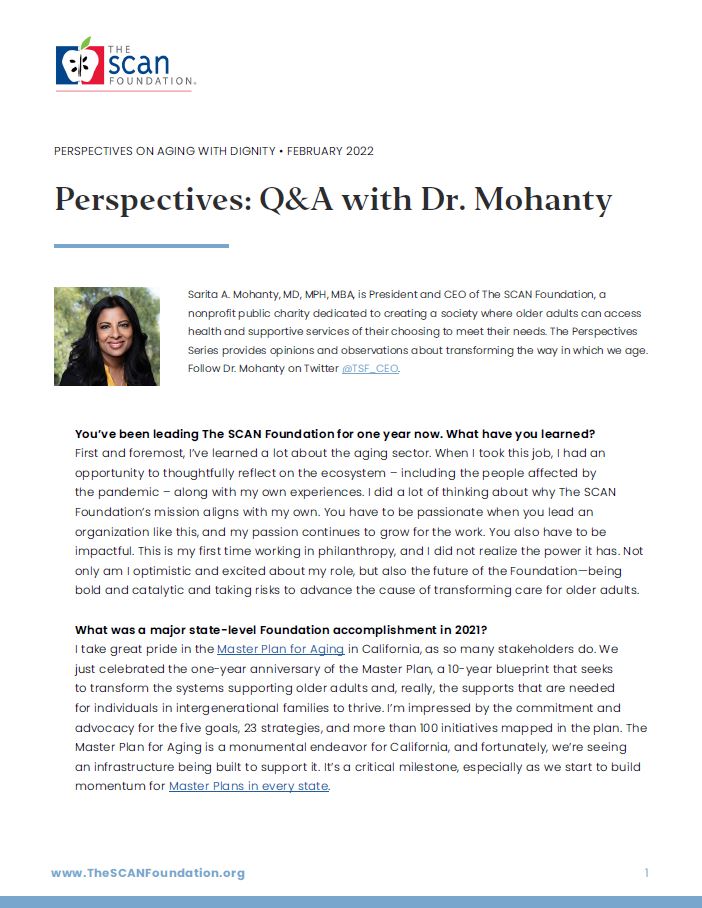Perspectives: Q&A with Dr. Mohanty
summary
In this February 2022 Perspectives, Dr. Mohanty answers several questions regarding The SCAN Foundation’s aims and progress during during her first year of leadership.
Date Updated: 02/07/2022You’ve been leading The SCAN Foundation for one year now. What have you learned?
First and foremost, I’ve learned a lot about the aging sector. When I took this job, I had an opportunity to thoughtfully reflect on the ecosystem – including the people affected by the pandemic – along with my own experiences. I did a lot of thinking about why The SCAN Foundation’s mission aligns with my own. You have to be passionate when you lead an organization like this, and my passion continues to grow for the work. You also have to be impactful. This is my first time working in philanthropy, and I did not realize the power it has. Not only am I optimistic and excited about my role, but also the future of the Foundation—being bold and catalytic and taking risks to advance the cause of transforming care for older adults.
What was a major state-level Foundation accomplishment in 2021?
I take great pride in the Master Plan for Aging in California, as so many stakeholders do. We just celebrated the one-year anniversary of the Master Plan, a 10-year blueprint that seeks to transform the systems supporting older adults and, really, the supports that are needed for individuals in intergenerational families to thrive. I’m impressed by the commitment and advocacy for the five goals, 23 strategies, and more than 100 initiatives mapped in the plan. The Master Plan for Aging is a monumental endeavor for California, and fortunately, we’re seeing an infrastructure being built to support it. It’s a critical milestone, especially as we start to build momentum for Master Plans in every state.
What was a major national Foundation accomplishment in 2021?
So many efforts helped shape the national policy discussion on home- and community-based care, and many are connected. I’ll highlight our work around building support for special supplemental benefits for the chronically ill (SSBCI). SSBCI differs from the traditional Medicare benefits we’re used to; they’re nonmedical yet so critical to someone’s ability to age and live well at home. Examples are home-delivered meals, grab bars, and even air conditioners. In our view, Medicare’s support for these things can lay the foundation for coverage in employer-sponsored benefits, Medicaid benefits, and more. We’re essentially creating a blueprint for how benefits need to change to support aging.
The Foundation’s vision is for older adults to age well in community. What are the challenges to achieving this vision, problems that the Foundation seeks to address?
The pandemic continued to be the overarching challenge of 2021, but it wasn’t the only one, and it’s important to reflect on what we’re witnessing. Our care delivery system continued to be overwhelmingly complex, made up of a patchwork of fragmented services. Though older adults try to stay independent, the services they need lack coordination and are often highly difficult to navigate—especially without a dedicated support person. We also witnessed inequities in how care is delivered, particularly affecting Black, Brown, and Indigenous communities; those with disabilities; and low-income and rural populations. We continued to grapple with the misalignment of financial incentives and policies needed to achieve person-centered care so that any older adult who needs supports and services can receive care in their homes and communities.
Pretend it’s 2025. How have state and federal policies and the resulting system changed to better support older adults who want to live well at home?
We will see more incentives aligned to support home- and community-based care for individuals, meaning state and federal policies will exist and plans will require value-based care. This will reduce reliance on hospitals and nursing homes unless an individual needs this level of care. When you need them, you need them; they’re not going to go away, but we recognize that people want their services delivered at home and in the community. So in 2025, we’ll have a vast array of options for older adults and their family caregivers. We’ll also see a lot of disruption and innovation related to these kinds of services, such as tech solutions combined with training, education, and access. I also anticipate more equitable approaches. Finally, I see more partnerships between the public and private sectors, accelerating the pace of change.

Sarita A. Mohanty, MD, MPH, MBA, is President and CEO of The SCAN Foundation, a nonprofit public charity dedicated to creating a society where older adults can access health and supportive services of their choosing to meet their needs. The Perspectives Series provides opinions and observations about transforming the way in which we age. Follow Dr. Mohanty on Twitter @TSF_CEO.
Continue Reading
This policy brief provides an introduction to The SCAN Foundation’s CLASS Technical Assistance Brief Series, which explores many of the critical issues to be considered for successfully implementing CLASS.
This policy brief describes the broad needs of individuals with disability and the wide range of supportive and environmental solutions that can allow for the most independent living possible. It suggests how findings on social and environmental supports for individuals with disability can inform implementation of CLASS.
This policy brief provides background on the historical development of benefit eligibility triggers in the private long-term care insurance market. Understanding how these triggers came into being can provide important information to those charged with implementing the CLASS Plan.


